Some people love nature and would like it more than anything to have beautiful small plants in their house and garden, but the thought of taking out time from their busy schedule to care and nurture the plants pushes away their wish.
If this sounds like your problem, you should keep aside your work and read this article about desert plants to help your problem.
The best thing about desert plants is that they can survive in a hot climate without much care and nourishment. They are adapted with a deep roots system that can go deep into the soil in a water shortage.
The leaves are modified naturally to have a fleshy core that helps in retaining water. Also, desert plants are extremely tough, and even if you cannot devote enough time to their care, they will not die that quickly.
So even if you are not a gardening specialist and you have a busy schedule, you can still enjoy a place full of potted desert plants or lots of greenery in your garden without putting in much effort.
Let us check out the top 26 desert plants for your home and garden.
26 Easy to Maintain Desert Plants
1. Bishop’s Cap
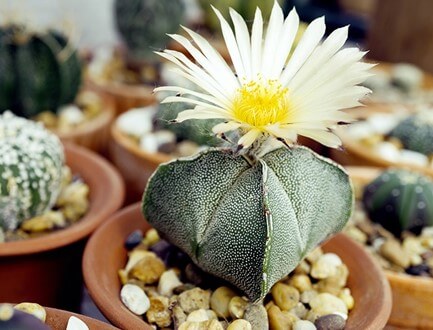
Found in a semi-spherical shape with deep ridges adorned with thorns, Bishop’s cap looks strikingly gorgeous with a ceramic or decorative pot. The plant grows no more than 100 cm tall with a maximum diameter of up to 20 cm.
There are four to five distinct deep ribs, which increase to eight as they grow old. Also, it develops a white layer on its surface, which might look like a disease to an amateur but do not worry, and it is just the plant’s defense mechanism to protect itself against sunlight.
All that your little green buddy needs are lots of sunlight and a little water to bloom those charming yellow flowers with multiple petals.
2. Golden Barrel Cactus

A golden barrel cactus plant is a popular desert houseplant mainly cultivated for this very purpose. With an almost perfectly round central trunk, these small cactus plants look super attractive, with even spaced golden spikes pointing out in all directions.
As they grow, the round shape tends to become a little oval, and they can stretch out to a big limit of about 6ft. However, their growth rate is prolonged, so you can have them as a houseplant long enough before they become too tall.
3. Angel Wing Cactus

A member of the prickly pear cactus family, the plant’s shape is true to its name, and the stems grow out in clusters. This cactus has evenly spaced clusters of hair in place of sharp spines, a feature unique to this species.
Depending on the species, it can grow to a height between 2ft – 5ft. The plants that receive a full day of sunlight bear pale yellow flowers followed by red, edible fruits. The adorable appearance, along with the brilliant contrast of yellow or red against green, makes it a perfect desert plant for your home.
4. Star Cactus

Also known as Astrophytum star cactus, this must be every desert plant lover’s favorite, owing to its super chic appearance. To bloom better, it needs to be kept in a sunny location and in well-drained soil that does not let the water stagnate near its roots.
With around green base trunk adorned with tiny white dots and fine white hair, good nurturing makes yellow flowers with orange center bloom, which later turns to a pinkish or reddish berry. Who knew a cactus could be this colorful, right?
5. Brittle Bush
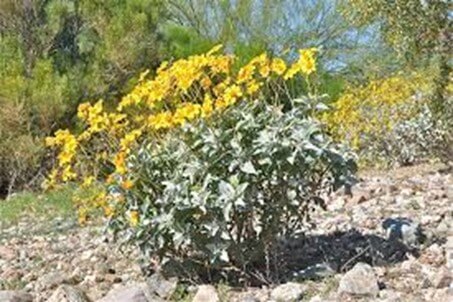
Brittle Bush is more like a shrub. Embellished with oval silver-grayish leaves with a hairy texture that gives way to charming yellow flowers between winter and spring, this desert plant serves several other purposes.
Apart from being a medicinal shrub, its charming scent has led people to name it the “incense plant.” Its sweet fragrance filling up your room or garden will impress your guests and provide you with a relaxing and soothing atmosphere.
Hence, if you are looking for a desert plant for your garden, what could be better than this, isn’t it?
6. Creosote Bush
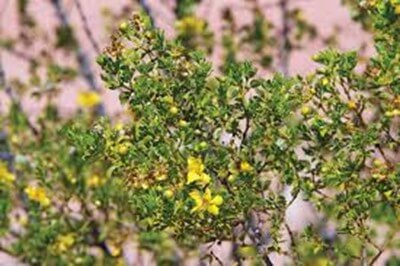
Blessed with a long lifespan that can stretch up to a hundred years, apart from being an easy-to-care-for desert plant, it is also known for its medicinal properties and its fascinating ability to adapt.
The large bush boasts a dense cluster of resin-stained leaves with gorgeous flowers blooming as per the season, which later turns to a silver-grayish fruit. This desert plant is not readily available in nurseries, but you can grow them yourself from seeds.
One important thing that you should keep in mind when choosing a Creosote bush is that it needs full daylight to bloom better. With a lesser amount of sunlight, the plant’s growth rate decreases, and the stems and leaves start to droop.
7. Desert Ironwood Plant
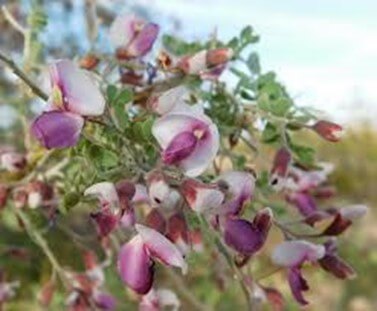
The most attractive feature of this desert plant is the gorgeous white & purple flowers. It also produces bluish oval leaves with a leathery texture. One of the popular things for which it is widely known is its dense heartwood that is so heavy that it cannot float in water.
They are adapted to survive in extremely dry conditions, so you can now boast a beautiful garden with purple blossoms without much garden work. Naturally, they tend to grow out a little bushy, but you can easily groom and shape them to match your garden.
One important thing that you should note is that although this plant being a desert plant, it can grow without too much care, and it can also become evergreen with proper nurturing.
8. Desert Sage Plant
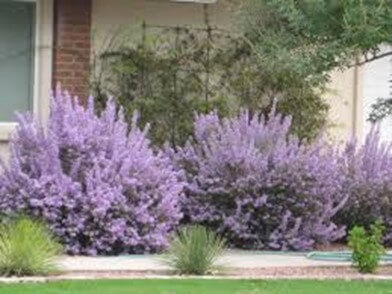
Regarded as one of the most rugged yet beautiful plants, desert sage can add to the beauty of your garden or house with its brilliantly contrasting bright purple and pale blue flowers that grow out in spike-like clusters bilaterally.
What adds up to its value is the unique fragrance emitted by its leaves when rubbed together. The plant does not grow more than 1 to 3 ft in height. One of the few flowering non-cactus desert plants takes very little nurturing and can easily survive in extreme heat and nutrient-deficient soil.
9. Desert Marigold

We have all seen marigold flowers. For those with little gardening knowledge, maintaining an average marigold plant takes a considerable effort, but that is not the same with a desert marigold.
Also known as paper daisies due to the flowers’ papery texture, these plants can grow up to 1ft with big bright yellow flowers with lots of seed.
Caring for a desert marigold is super easy. However, these plants are short-lived and live till the end of summer, but the good news is they always return next year.
10. Desert Willow Tree

If you are looking for something that adds color and fragrance to even a small garden, the desert willow tree is the perfect desert plant for you.
The fragrant trumpet-shaped flowers usually bloom at the thin branches’ tip and come in various shapes like pink, purple, or white with yellow centers.
The delicate plant with multiple trunks would not just help you with a shade during the summer but will also provide heating in colder months. It is a perfect way to style up your garden with beautiful delicate fragrant flowers.
11. Desert Lily
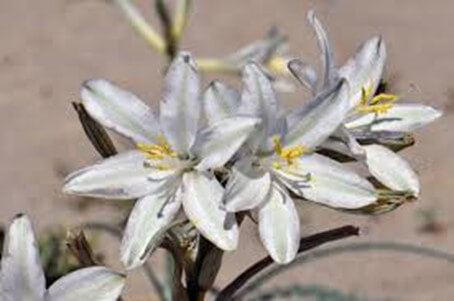
Another popular desert plant is known for its fascinating colors and exotic fragrance. The plant consists of clusters of blue-green leaves with large cream-colored flowers shaped like a funnel that grows between March to May.
The big white flowers have green or silver mid strips, which emits a sweet fragrance. Each flower has six petals with a silver lining on the back of each. These bunch of fragrant flowers can grow up to a foot long and can bring a spring-like look to your garden even in summer.
12. Turpentine Bush

Native to the southwestern United States, the Turpentine bush is adapted to grow amid extreme desert heat and a fatally low temperature as low as 10 degrees Fahrenheit.
Now that is what we call a perfect desert plant. The plant’s foliage is covered in sticky resin, which, although it does not add up to its fragrance,e acts like a defense mechanism to keep away pests.
The plant consists of dark green leaves in the shape of a needle but soft in terms of texture, which gives way to a cluster of attractive bright yellow flowers.
13. Mojave Aster

The list for desert plants can never be complete without mentioning Mojave Asters. The best thing about them is that they bloom late into summer and well throughout fall.
The off-season blooming helps you retain your garden’s color while all the other plants are on a break during the fall. Another striking feature unique to this species is that its leaves and flowers can be eaten, either fresh or used in meals like soup and salad.
Although it is no longer a common practice, certain natives still like their piece of Aster on their plates. Anyway, all that we are concerned about is the gorgeous flowers that will make your garden look 100 times better.
14. Jumping Cholla

The one thing that you should be careful about when picking a jumping cholla cactus is its nasty spines that tend to get stuck in your skin quickly. The spikes are covered with a papery sheath, which gives it an attractive colorful appeal, precisely what you are looking for in your garden.
Also, being a desert plant can tolerate extreme heat conditions and shiver cold with a temperature as low as 5 degrees Fahrenheit. You must keep in mind that this desert plant requires well-drained soil and plenty of sunlight to survive.
15. Elephant Tree

The best feature of this desert plant is it can go without water for an extended period. Owing to its rough brownish trunk and small green leaves, which make it look like a miniature version of a real tree, they are mostly used in bonsai.
During winters, the tree blooms with a bunch of tiny red flowers. When choosing an elephant tree, make sure you place them in well-drained soil that does not retain water for too long. You may want to install some LED grow lights indoors to make sure the plant gets enough sun. You can get help at Agron.
16. Yellow Paloverde

If you are looking forward to decking up your backyard with gorgeous flowering desert plants, then this can be on your top 5. It is adapted to survive in drought-tolerant landscapes under extreme weather conditions.
It can grow up to a height of 15 to 30 ft with an attractive pattern of branching with proper sunlight. To add a cherry on top, these branches are adorned with pale yellow flowers that last long.
This desert plant is mainly known for its healthy, sturdy branches, rapid growth, fewer falling leaves, and obviously, the charming yellow flowers.
17. Triangle Leave Bursage
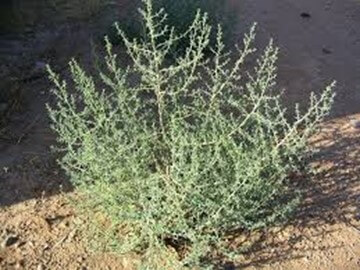
A native plant of the Sonoran Desert, this desert plant is a small shrub that has many slender branches growing out the base to give it a dome crown-like structure. The younger branches are sharper and tend to get smoother with age.
Small yellow-green flowers bloom in pairs from the tip of the spike towards the end of February. The triangle leaves bursage is drought-deciduous, and it loses its leaves in the dry season.
18. Desert Palm

Many of you might not know this, but this tall desert tree is also a popular indoor desert plant. Before you confuse them as tropical plants, let us clear first that there are 2600 different palm species, and here we are discussing desert palm.
Owing to the lesser amount of care needed for a desert palm to thrive, it is a brilliant choice for your home landscape or the pots indoors. With the usual bright green trunk with large green leaves in the shapes of strips growing out in all directions from the center, it exactly looks like the miniature version of a regular palm tree.
19. Mesquite Tree
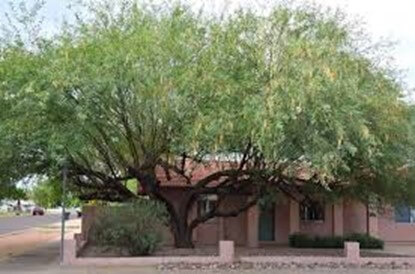
With fewer pest attacks, mesquite trees are easier to care for at home. The dual root structure, one for the deep levels of soil and the other being shallow helps this desert plant adapt to survive in the driest soils with significantly less water.
It has a rough shrub-like appearance in dark green. Apart from the shrub’s sweet fragrance, it is a legume, which means it restores the lost nitrogen in your soils and makes your soil remains rich in minerals.
20. Love Grass
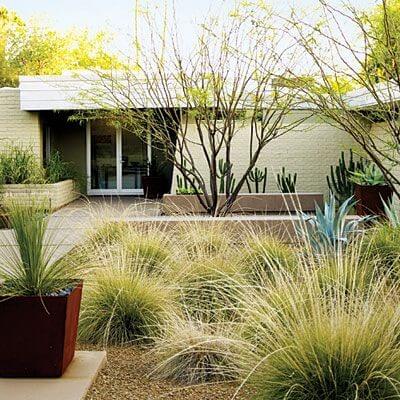
An excellent desert plant that has high levels of drought tolerance is an excellent way of adding a colorful touch to your garden with plants that has a soft texture. They grow slowly to form a meadow with their fluffy cloud-like clusters of flowers and a desert plant, and it is super easy to nurture and care for it.
The leaves grow out in small bunches with flat blades, and their seeds are generally tiny. So, it is easy to care for, stays for almost a year, adapts to extreme weather conditions, especially heat, and will surely add a beautiful artistic touch to your garden. What else do we need?
21. Thyme Plant

Another popular desert plant on the list! Thyme is known for its exotic aroma. Thyme can survive even in indirect sunlight, which makes it suitable for being a houseplant. The best result on thyme can be achieved with about 6 to 7 hours of sunlight daily.
The slender stems emerge from the center and grow out in all directions making a spiral structure. Each stem boasts a cluster of tiny green leaves that are meant to last long. They are also used in salad dressings, much owing to their delicious fragrance.
22. Oleander Plant
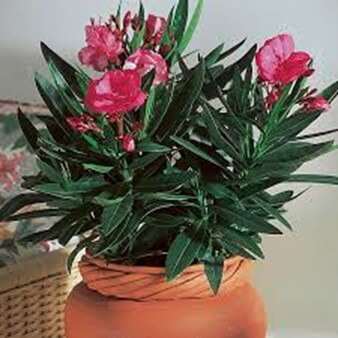
A gorgeous desert plant with beautiful pink flowers, Oleander is the perfect desert plant for your pots at home. It is a very carefree plant and can grow without much nurturing. However, to obtain the best results, it is better to place it near a window where it can get enough daylight.
Water it in small amounts till the spring season arrives, after which you can increase the amount to make the plant flourish and bloom even better. This plant is available in four different colors, including red, yellow, white, and pink, and the best part is that you can grow it both indoors and outdoors.
23. Emu Bush

Emu bush is much better suited as a backyard plant instead of an indoor plant. This desert plant is evergreen, adapted against extreme conditions of weather including drought, and are winter bloomers. In most regions, once it starts growing, constant watering is not required.
The flowers are tubular in shape and split at the end in a way that makes it look like it is growing inwards. It comes in various shades of red, pink, and magenta shades with yellow highlights.
The best thing about this plant is that it boasts a branch full of flowers from node to tip and it is all that you need to impress your guests with your beautiful garden.
24. Christmas Cactus

A gorgeous cactus with beautiful pink flowers, this desert plant is also a perfect house plant. One of the biggest reasons for its popularity is its flowers. When this plant blooms, it produces mesmerizing flowers in tubular shape in the shade of pink or lilac.
These flowers often stay fresh for a long time even without a lot of care and nurturing. However, they are a little different from regular cacti. It is true that they need much less care in comparison to other plants, but they cannot bear the same amount of sunlight and dry hot weather as other cacti can.
Also, it needs to be watered more frequently in comparison to other cacti. But to conclude, the gorgeous flowers make all this little extra care worth it.
25. Fairy Castle Cactus

This desert plant has thick sturdy spines that bloom into yellow flowers occasionally. This desert plant gets its name from its structure. The slender green stems arrange themselves in clusters that look a lot like a fairytale castle.
The stems on the plant are in bright green which turns brownish with age. Each stem has 5 parts filled with woolly-based thorns throughout. They need a lot of daylight and well-drained soil to bloom better and make sure you put it away from an air conditioner. This desert plant is also a perfect winter plant that is apt for the pots at your home.
26. African Milk Tree
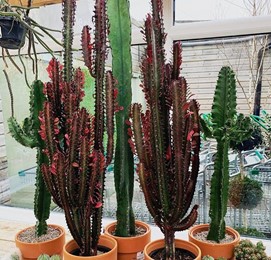
This desert plant gets its name from the milky sap in its leaves but is careful because the sticky sap is often toxic and irritates the skin.
The leaves grow along the edges of the step containing two different sets of thorns on them. When growing outdoors, the plant blooms tiny yellow or white flowers depending on its environment, adding to its beauty.
And one thing remains constant, and if you are someone with a busy schedule or travel a lot, then his plant is your perfect buddy!
These were the top 26 desert plants that you can grow in your home in pots or your garden. A simple, time-saving way to glamorize your garden with lovely desert plants and bring back some life to your dead garden.
We hope this article was helpful for you, and if you have any further queries regarding desert plants, do not feel shy to reach out to us in the comment section below. Also here is a little tip – You can add beautiful flowers too to your collection.

